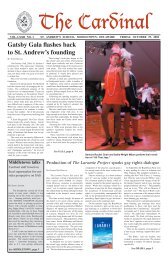Sl:ANDREWS - Saint Andrew's School Archive - St. Andrew's School
Sl:ANDREWS - Saint Andrew's School Archive - St. Andrew's School
Sl:ANDREWS - Saint Andrew's School Archive - St. Andrew's School
You also want an ePaper? Increase the reach of your titles
YUMPU automatically turns print PDFs into web optimized ePapers that Google loves.
items as accuracy, clarity, courtesy, and<br />
maturity. If there is a particular<br />
problem on the school record or the<br />
application which needs further amplification,<br />
the parent should feel free to<br />
write the college. Just as colleges keep<br />
files on students, so should students<br />
keep files on colleges. Included in the<br />
files should be copies of letters, notes,<br />
and rough drafts of essays. In matters of<br />
correspondence with colleges, filling out<br />
applications, and writing the required<br />
essays, your youngster's advisor is<br />
available to help him or her in checking<br />
details or unsnarling a particular knot.<br />
We check with students to make sure<br />
deadlines are met and that questions<br />
about administrative detail are answered<br />
promptly and accurately. On the other<br />
hand, an inordinate number of requests<br />
for proofreading by advisors or the<br />
necessity to prod students constantly<br />
about meeting clearly-understood and<br />
inescapable deadlines might be seen as a<br />
warning flag that the youngster may not<br />
yet be ready to move on to college.<br />
Responsibility<br />
Everyone involved in the college admissions<br />
process has responsibilities. As a<br />
school our job is to help the students get<br />
started, to give them an initial list, to<br />
provide them with resource materials, and<br />
to give them educated guesses as to their<br />
prospects at certain institutions. In addition,<br />
a major job of ours is to help<br />
students and parents arrive at an accurate<br />
evaluation of demonstrated talent and<br />
potential. In a sense, of course, that is why<br />
we are called "counselors"; we counsel,<br />
and we may say things to parents or<br />
students that they don't particularly want<br />
to hear. Even if a parent did well at a<br />
"prestigious" college, it is possible that his<br />
or her child will not measure up to today's<br />
pool of candidates at that college. Times<br />
change, policies change, and so do admissions<br />
offices.<br />
The students' responsibility revolves<br />
around their being able to take the<br />
initiative, do research, visit colleges, and<br />
meet deadlines. We expect them to ask<br />
questions (since it is impossible for us to<br />
anticipate them all) and to keep us informed<br />
of the difficulties they encounter<br />
and the progress they make. As far as<br />
possible, students should also make interview<br />
appointments themselves and<br />
follow up with any necessary correspondence.<br />
We believe that parents bear a strong<br />
responsibility in this process too. They<br />
should be an objective sounding board for<br />
their children and help them think out<br />
loud. They should discuss realistic goals<br />
with their children and be supportive (as<br />
well as instructive) during this tough and<br />
emotional process. It is certainly understandable<br />
that parents have feelings<br />
about one school or another, but just as we<br />
6<br />
do not "select" a college for a student,<br />
neither should parents do so.<br />
Choosing a College<br />
Few students can safely apply to only one<br />
college. We encourage multiple applications,<br />
and the student must be careful<br />
in his selection. We urge that students aim<br />
high, but at the same time they should be<br />
realistic and use a "vertical" list. Applications<br />
should be sent to a group of<br />
colleges which vary in degrees of admission<br />
difficulty.<br />
In the beginning students are usually<br />
overwhelmed by the great number of<br />
possible colleges. There are, for instance,<br />
over 1500 colleges in the United <strong>St</strong>ates, and<br />
a number of these would probably be<br />
"right" for a particular student. So, as you<br />
often do when choosing cars, you start with<br />
many options and gradually narrow the<br />
field based on the factors which students<br />
consider most important. During the<br />
process a student should remember that<br />
college catalogues are only one source of<br />
information. One needs to go beyond<br />
official literature to include visits and<br />
conversations with us, with students at the<br />
colleges, and with parents. While others'<br />
views should be taken with some skepticism,<br />
much of the advice from these<br />
sources will be useful.<br />
"A solid class rank is tangible<br />
evidence ofperformance and in<br />
most cases more persuasive. .. "<br />
Trends<br />
Looking over college profiles for the past<br />
two or three years, I believe it is safe to say<br />
that our students have concentrated their<br />
efforts in three primary areas-the Northeast,<br />
the Middle Atlantic, and the South.<br />
There does not seem to be the great interest<br />
in small rural colleges (Amherst, Bowdoin,<br />
Colby, Middlebury, Williams) that New<br />
England schools experience, but perhaps<br />
that is simply a function of numbers. Our<br />
graduating class is small enough so that we<br />
probably never will have more than two or<br />
three applications in a given year to any of<br />
these schools. Also, because the majority<br />
of our students come from within a 200<br />
mile radius of <strong>St</strong>. <strong>Andrew's</strong>, a trip to the<br />
"hinterlands" to visit some of those<br />
schools is more of a major undertaking<br />
than when one lives in New England.<br />
We have also noticed that girls in our<br />
graduating classes tend not to apply to<br />
women's colleges. Perhaps this is not so<br />
much a <strong>St</strong>. <strong>Andrew's</strong> trend as a national<br />
trend, but the facts are clear: In the last<br />
three years fewer than 20l1Jo of our<br />
graduating girls have selected single-sex<br />
institutions.<br />
A third trend is, perhaps, simply an<br />
affirmation of what we all have feared: it is<br />
just as difficult now as it has been in the<br />
past, to get into the handful of "most<br />
competitive" colleges. Many of these<br />
colleges have doubled their applicant pool<br />
by going co-educational in recent years.<br />
Most have an applicant-place ratio of 8,9,<br />
or 10-1. Most have a deep commitment to a<br />
certain percentage of minority students. All<br />
are in an aggressive nationwide search for<br />
the exceptional candidate. Some are<br />
perceived as "prep schools" for graduate<br />
school. And, needless to say, these colleges<br />
do pay very close attention to the Board<br />
scores.<br />
Finally, inflation has taken its toll on<br />
both the supplier and the consumer in the<br />
education business. It costs more than ever<br />
to educate students, and, therefore, it costs<br />
more than ever to be educated. Many<br />
families are understandably concerned<br />
about how to meet mounting expenses, yet<br />
there is a note of optimism regarding this<br />
albatross. What is important to keep in<br />
mind is that the relative level of college<br />
costs as a percentage of average family<br />
income has not in fact changed very much<br />
in the past 10-15 years. Furthermore, state<br />
and federal governments now provide<br />
much more student aid than in the past,<br />
and most colleges have expanded their own<br />
financial aid packages considerably. Each<br />
year more families file the Financial Aid<br />
Form, and each year some families are<br />
surprised to learn that, in fact, they do<br />
qualify for scholarship funds. Even those<br />
families who do not qualify for outright<br />
grants may find other resources available to<br />
them for paying college costs. In short, I<br />
believe that all institutions (private ones<br />
included) are now more accessible to<br />
students from all income levels than ever<br />
before.<br />
<strong>St</strong>. <strong>Andrew's</strong> Role<br />
It is important that students understand<br />
that no one should just go to college in the<br />
way one would go to a concert, to a movie,<br />
or to England for a visit. College should<br />
not be chosen as a nice (or inevitable) place<br />
to be for four years. It should be chosen<br />
because it will further shape a student's<br />
values and talents and give direction to his<br />
life.<br />
We do everything we can to guide and<br />
support our students in the college application<br />
process. We urge them to "shoot<br />
high," and, at the same time, we ask them<br />
to apply to a college they are certain to be<br />
able to enter. We provide resources and<br />
administrative assistance. Yet, ultimately<br />
the students themselves are the biggest<br />
factors in college admissions. The ways<br />
they present themselves, in person and on<br />
paper, and the records they build here,<br />
both in and out of the classroom, determine<br />
the roads they will travel when they<br />
leave <strong>St</strong>. <strong>Andrew's</strong>.<br />
0<br />
See Page 2 for /979 College Profile

















